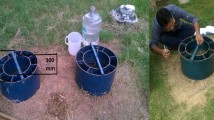Abstract
The aim of this paper to assesses the potential of machine learning approaches, i.e. multi-linear regression (MLR), support vector regression (SVR), Gaussian process (GP) regression of cumulative infiltration and compares their performances with three traditional models [Kostiakov model, US-Soil Conservation Service (SCS) model and Philip’s model]. Data set as many as 413 were obtained by conducting experiments in laboratory of NIT Kurukshetra. It is observed from the experiments that moisture content influences the cumulative infiltration of soil. Out of 413 data set 289 arbitrary selected were used for training the models, whereas remaining 124 were used for testing. Input data set consist of time, sand, rice husk ash, fly ash, suction head, bulk density and moisture content where as cumulative infiltration was considered as output. Two kernel function i.e. Pearson VII and radial based kernel function were used with both SVR and GP regression. The results after comparison suggests that the GP regression based approach works better than SVR, MLR, Kostiakov model, SCS model and Philip’s model approaches and it could be successfully used in prediction of cumulative infiltration data.
















Similar content being viewed by others
References
Cortes C, Vapnik V (1995) Support-vector networks. Mach Learn 20(3):273–297
Devices D, 2014. Mini disk infiltrometer user’s manual, version 9. Decagon Devices, Pullman
Dibike YB, Velickov S, Solomatine D, Abbott MB (2001) Model induction with support vector machines: introduction and applications. J Comput Civil Eng 15(3):208–216
Elbisy MS (2015) Support vector machine and regression analysis to predict the field hydraulic conductivity of sandy soil. KSCE J Civ Eng 19(7):2307–2316. doi:10.1007/s12205-015-0210-x
Gill MK, Asefa T, Kemblowski MW, McKee M (2006) Soil moisture prediction using support vector machines. JAWRA J Am Water Resour Assoc 42(4):1033–1046
Green WH, Ampt G (1911) Studies on soil physics, 1. The flow of air and water through soils. J Agric Sci 4:1–24
Holtan HN (1961) Concept for infiltration estimates in watershed engineering. Agricultural Research Service, U.S. Department of Agriculture
Horton RE (1941) An approach toward a physical interpretation of infiltration-capacity. Soil Sci Soc Am J 5(C):399–417
Jury WA, Gardner WR, Gardner WH (1991) Soil physics, 5th edn. Wiley, New York
Karandish F, Šimůnek J (2016) A comparison of numerical and machine-learning modeling of soil water content with limited input data. J Hydrol 543:892–909. doi:10.1016/j.jhydrol.2016.11.007
Kostiakov AN (1932) On the dynamics of the coefficient of water-percolation in soils and on the necessity of studying it from a dynamic point of view for purposes of amelioration. In: Trans. 6th Cong. International. Soil Science, Russian Part A, pp 17–21
Kuss M (2006) Gaussian process models for robust regression, classification, and reinforcement learning, PhD thesis, Technischen Universität Darmstadt
Lamorski K, Pachepsky Y, Sławiński C, Walczak RT (2008) Using support vector machines to develop pedotransfer functions for water retention of soils in Poland. Soil Sci Soc Am J 72(5):1243–1247
Mirzaee S, Zolfaghari AA, Gorji M, Dyck M, Dashtaki SG (2014) Evaluation of infiltration models with different numbers of fitting parameters in different soil texture classes. Arch Agron Soil Sci 60(5):681–693. doi:10.1080/03650340.2013.823477
Mishra SK, Tyagi JV, Singh VP (2003) Comparison of infiltration models. Hydrol Process 17(13):2629–2652. doi:10.1002/hyp.1257
Pal M (2006) Support vector machines-based modelling of seismic liquefaction potential. Int J Numer Anal Methods Geomech 30(10):983–996. doi:10.1002/nag.509
Pal M, Deswal S (2008) Modeling pile capacity using support vector machines and generalized regression neural network. J Geotech Geoenviron Eng 134(7):1021–1024. doi:10.1061/(ASCE)1090-0241(2008)134:7(1021)
Pal M, Singh NK, Tiwari NK, 2011. Support vector regression based modeling of pier scour using field data. Eng Appl Artif Intell 24(5):911–916. doi:10.1016/j.engappai.2010.11.002
Pedretti D, Barahona-Palomo M, Bolster D, Sanchez-Vila X, Fernàndez-Garcia D (2012) A quick and inexpensive method to quantify spatially variable infiltration capacity for artificial recharge ponds using photographic images. J Hydrol 430:118–126. doi:10.1016/j.jhydrol.2012.02.008
Philips JR (1957) The theory of infiltration: the infiltration equation and its solution. Soil Sci 83(5):345–357
Rasmussen CE, Williams CKI (2006) Gaussian processes for machine learning. The MIT Press, Cambridge
Richards LA (1931) Capillary conduction of liquids through porous mediums. J Appl Phys 1(5):318–333
Schuh WM, Bauder JW (1986) Effect of soil properties on hydraulic conductivity–moisture relationships. Soil Sci Soc Am J 50(4):848–855. doi:10.2136/sssaj1986.03615995005000040004x
Sihag P, Tiwari NK, Ranjan S (2017) Estimation and inter-comparison of infiltration models. Water Sci 31(1):34–43. doi:10.1016/j.wsj.2017.03.001
Singh VP, Yu FX (1990) Derivation of infiltration equation using systems approach. J Irrig Drain Eng. doi:10.1061/(ASCE)0733-9437(1990)116:6(837)
Singh KK, Pal M, Ojha CSP, Singh VP (2008) Estimation of removal efficiency for settling basins using neural networks and support vector machines. J Hydrol Eng 13(3):146–155
Singh BK, Tiwari NK, Singh KK (2016) Support vector regression based modelling of trapping efficiency of silt ejector. J Indian Water Resour Soc 36(1):41–49
Singh B, Sihag P, Singh K (2017) Modelling of impact of water quality on infiltration rate of soil by random forest regression. Model Earth Syst Environ. doi:10.1007/s40808-017-0347-3
Smola AJ (1996) Regression estimation with support vector learning machines. Master’s Thesis, Technische Universität München, Germany
Üstün B, Melssen WJ, Buydens LMC (2006) Facilitating the application of support vector regression by using a universal Pearson VII function based kernel. Chemometr Intell Lab Syst 81:29–40. doi:10.1016/j.chemolab.2005.09.003
Vapnik VN (1995) The nature of statistical learning theory. Springer, New York
Vapnik VN, Vapnik V (1998) Statistical learning theory, vol 1. Wiley, New York
Vereecken H, 1995. Estimating the unsaturated hydraulic conductivity from theoretical models using simple soil properties. Geoderma, 65(1–2), 81–92. doi:10.1016/0016-7061(95)92543-X
Zolfaghari AA, Mirzaee S, Gorji M (2012) Comparison of different models for estimating cumulative infiltration. Int J Soil Sci 7(3):108
Author information
Authors and Affiliations
Corresponding author
Rights and permissions
About this article
Cite this article
Sihag, P., Tiwari, N.K. & Ranjan, S. Modelling of infiltration of sandy soil using gaussian process regression. Model. Earth Syst. Environ. 3, 1091–1100 (2017). https://doi.org/10.1007/s40808-017-0357-1
Received:
Accepted:
Published:
Issue Date:
DOI: https://doi.org/10.1007/s40808-017-0357-1




